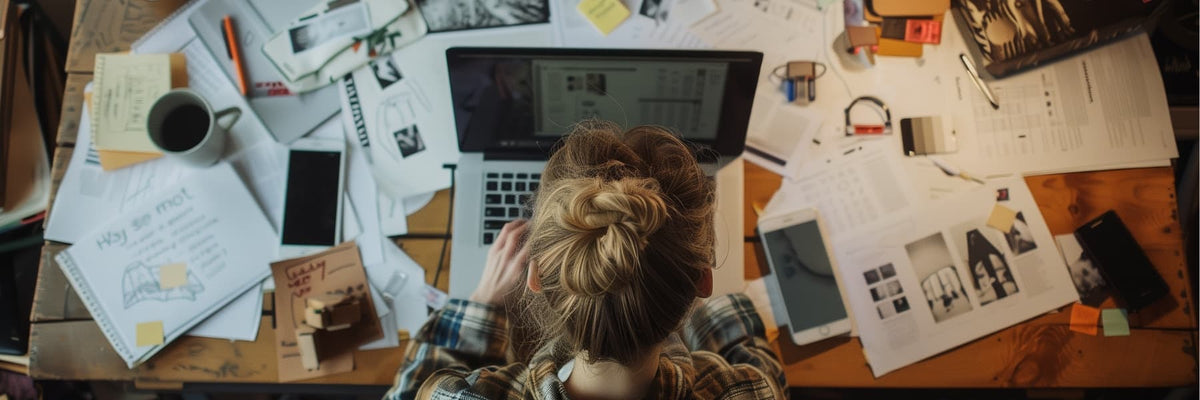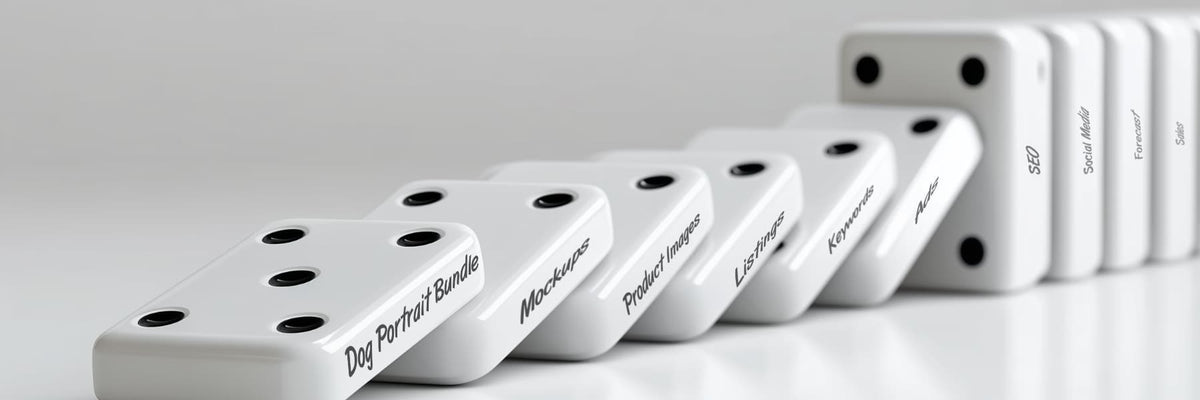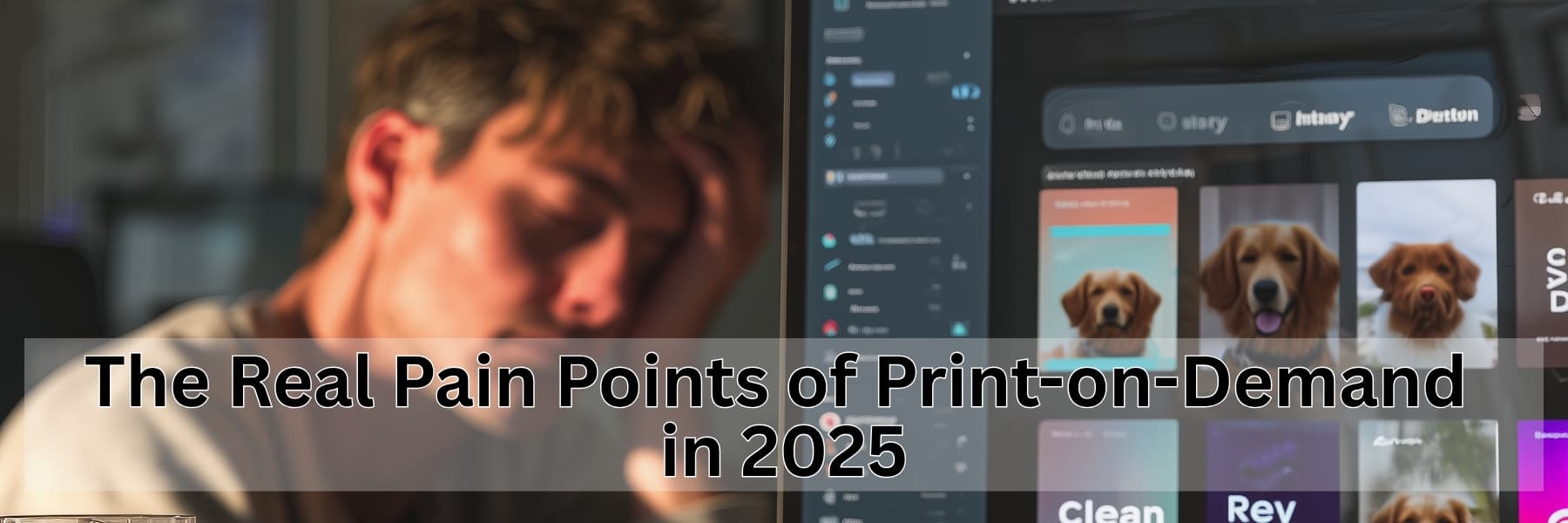Your Photo, Your Design
Get a Custom Artwork Made Just for You!
Turn your favorite photo into a personalized artwork. Whether it's a special memory, a loved one, or a pet, we'll create a unique piece just for you — perfect for gifts or keepsakes.
The Real Pain Points of Print-on-Demand in 2025 — and One Fix That Helps
Print-on-demand was supposed to be freedom.
The promise was clear: low risk, no inventory, endless creativity, and the ability to run your own business from a laptop. You imagined sipping coffee while your designs sold overnight. You imagined waking up to “cha-ching” sounds, automations ticking in the background, and a growing catalog of evergreen products.
But if you’re actually in the trenches—uploading listings at 1 AM, replying to support tickets on your lunch break, or manually resizing yet another inconsistent AI mockup—you know how far that fantasy is from reality.
Let’s be honest: POD can be powerful. But it’s not passive. It’s not predictable. And it’s not easy.

What a POD Seller’s Week Really Looks Like (And Why It’s Not Working)
If you’re a solo seller or a two-person team, here’s what your average week might actually look like.
You wake up with a list of ideas and good intentions — but by noon, you’re stuck fixing mockups, rewriting a product description, and replying to yet another confused message about shipping. Every little task takes longer than it should, and the time you hoped to spend on growing your business gets eaten up by putting out fires.
-
1. Unpredictable Cash Flow: Reserves, Holds, and Delays
You sold $500 in a weekend. But only $200 hits your account.
Etsy, Shopify Payments, PayPal, and other platforms often hold a portion of payouts in reserve—especially for new sellers, sellers with low volume, or any account that had a refund spike. It doesn’t matter that your supplier already charged your card. The platform still holds your money “just in case.”
Even worse? The better your store performs, the tighter the cash feels. More orders = more production costs upfront = more risk you’re covering personally.
So instead of reinvesting in marketing or launching new designs, you’re pulling from savings. That’s not “low risk”—that’s acting as your own venture capitalist.
-
2. Listing Takedowns, DMCA Abuse & Policy Vagueness
You did everything right. Original artwork. Licensed fonts. No Disney knockoffs.
Then you wake up to the dreaded red banner:
“Your listing has been removed due to intellectual property infringement.”
The reason? Could be a troll. Could be an automated bot. Could be another seller reporting you just to tank competition.
Etsy’s default is to side with the accuser. Your listing is removed immediately. To appeal, you have to file a DMCA counterclaim — which requires your full legal name, address, and sometimes a lawyer’s help. And while you wait 10–14 days? That product is gone from search.
One takedown won’t end your store — but it can crush your momentum and demoralize your week.
-
3. Search Feels Like a Black Box
One week: 80 visits a day.
Next week: 3.
No reason. No warning. No way to know what changed.Etsy, Amazon, and even Pinterest offer vague advice: “Optimize your listings.” “Use better tags.” “Maintain good reviews.” But behind the scenes, it’s chaos. One delayed message reply can tank your visibility. A single buyer who claims they didn’t receive their order (even if they did) might impact your rank.
Try uploading five listings without early traction? You could suppress your whole shop.
You're not just selling POD products — you’re navigating invisible, ever-shifting algorithm rules that feel like a guessing game.
-
4. Production Delays and Lack of Control
POD was supposed to be hands-off. But when your provider misses a ship date, guess who gets the angry message?
Printify and Printful both list “2–5 business days” for production. But in Q4? That stretches to 10+. During viral trends? Even longer.
And you can’t fix it. You’re stuck relaying updates from a helpdesk you don’t control. The buyer doesn’t care that it’s “POD” — they care that their gift isn’t arriving in time.
Even worse: if you sell globally, shipping times are all over the place — and buyer patience is lower than ever.
-
5. Inconsistent Product Quality
You approved the design. You ordered the sample. It looked perfect.
But then a real buyer gets a tee with off-center print. Or a mug with smudged colors. Or a pillow that sheds glitter for some reason.
You didn’t see it. You can’t fix it. And you still get the refund request.
Worst of all? That buyer may leave a 2-star review for your brand — because the printer doesn’t show up on the product page. You do.
-
6. Returns You Can’t Afford
You tell yourself: “Returns will be low. It’s print-on-demand.”
Reality check:
- - Industry-wide return rate in 2024: 16.5%
- - Apparel returns are even worse—especially due to “bracketing” (buyers ordering 3 sizes and returning 2)
- - POD means returns are destroyed, not resold. You eat the loss.
If you price your items assuming no returns, you’re gambling with your margins. And if you do bake that risk in, your pricing may scare buyers away.
-
7. Ad Spend That Doesn’t Pay Back
You try Etsy Ads. $15 a day. You used to get 3–4 sales. Now? Maybe one.
Clicks are more expensive. ROAS is murky. Attribution is broken due to iOS changes. Most buyers “browse now, buy later,” so your campaign doesn’t even get credit for the sale.
You try Pinterest. You try Meta. You try TikTok Spark Ads. But now you’re managing campaigns instead of building products — and burning cash just to maybe stay visible.
-
8. Shop Feeds and Grids That Look Like Chaos
You’re proud of your catalog. But from the outside?
It looks random. Inconsistent. Disjointed.
- - Some mockups are light. Others are dark.
- - Some use retro script. Others bold sans.
- - Some products show in lifestyle settings. Others are floating PNGs.
To you, it's a creative journey. To the buyer? It looks like a store that doesn’t know what it is yet.
And confusion kills conversion.
-
9. Mental Load and Decision Fatigue
You’re not just a designer. You’re a one-man-band:
- - SEO analyst
- - Product researcher
- - Social media manager
- - Customer support rep
- - Refund handler
- - Print quality checker
- - AI prompt whisperer
And you’re supposed to stay creative, optimistic, and consistent through all of that.
Burnout isn’t a failure. It’s the default outcome when the workload never ends and the wins feel buried under friction.
-
10. No Time to Actually Build a Brand
Every tutorial tells you: build your email list. Post consistently. Create collections. Tell your story.
But your reality?
- - Redoing the last mockup because the shadow looks off or the product photo came back off-center.
- - Rewriting “Digital files only – no physical product” because people keep missing it.
- - Creating yet another Canva shipping status graphic to explain to a buyer that yes, the mug is coming.
You’re not building brand equity. You’re firefighting.

You Control How Quickly You Launch
So what’s really eating your time?
It’s not the lack of ideas. It’s the sludge in the middle — the dozens of annoying, repetitive, low-leverage tasks between having an idea… and actually publishing it.
The steps that don’t feel creative. Just exhausting.
- - Trend research: You’re bouncing between Etsy, EverBee/ERank, Pinterest, TikTok trends, niche boards, trying to guess what buyers want before it hits saturation.
- - Prompt wrangling: MidJourney gives you a dog with three ears. ChatGPT writes another “trendy T-shirt slogan” that sounds like a Dad Joke from 2014.
- - Image cleanup: The dog’s paw is weird. The fur is over-textured. The background won’t fully erase. Now you’re zooming in at 800% in Canva or GIMP, fixing pixels.
- - Visual consistency: The art style is too different from last week’s bundle. It clashes. So you try to regenerate. But MJ refuses to give you the same look twice.
- - Upscaling and prepping: You're adjusting contrast, sharpening edges, removing soft glows, fixing misplaced shadows.
- - Placement headaches: You finally place it on a tote — and it looks weird. Off-balance. Too low. Try again. Still not right.
- - Mockups are inconsistent again: One batch had a vintage look. The next looks modern. Your store grid looks like a flea market.
- - Writing the listing (again): “Made-to-order.” “Printed and shipped by our partner.” “Delivery in 7–10 business days.” You rewrite it again and again, hoping to prevent the next angry message: “Why hasn’t this shipped yet?” or “I thought this was Prime.”
- - Naming it. You type “Golden Retriever mug” into Etsy and see 8,000 results. “Retro dog gift”? Already taken. “Coffee and Canines”? Nice… but someone’s using it. You scroll, second-guess, try to be clever without being corny, and wonder how long naming a product is supposed to take.
By the time you hit “Publish,” you’ve lost three hours.
Do that 5 times in a week — and you’ve spent more time grinding than creating.
-
Connect Through Detail
Focus on the features that make each breed recognisable. A well‑drawn snout, ear shape or coat pattern can make all the difference. This isn’t about complex poses or bodies; it’s about capturing the essence of the dog’s face so owners feel an immediate connection.
-
Offer Variety Without Losing Identity
Instead of churning out dozens of nearly identical portraits, develop a handful of high‑quality illustrations for each breed and render them in different styles. Playful doodles, sleek minimalism, retro colour palettes or painterly textures can appeal to different tastes while keeping the breed recognisable. This approach keeps your catalogue fresh and adaptable across products like stickers, t‑shirts and planners.
-
Consistency Builds Trust and Scale
We keep our portraits consistent in terms of proportion and framing. When each breed’s face is centered and scaled similarly, you can easily drop them into various templates without constant adjustments. It also signals professionalism and attention to detail, which helps build trust with customers and streamlines your workflow as you expand.
-
Why It Works
Breed‑specific portraits aren’t just another product; they tap directly into the bond between pets and their owners. When someone recognises their dog’s features in your artwork, they feel seen. That personal relevance turns browsers into buyers and buyers into repeat customers. In a crowded market, tailoring your designs to specific breeds is a subtle yet powerful way to stand out — and when you need a reliable base of breed‑specific illustrations to keep your catalogue fresh, resources like our dog portrait bundles can help you diversify without redrawing each face.

The One Fix That Moves the Needle
Let’s be clear: no single solution will solve all this.
We’re not pitching magic. We’re not promising a dream. But we are offering a shortcut through the ugliest part of the POD process: that mess in the middle between “idea” and “upload.”
Here’s what we built:
-
✅ Ready-to-Use Dog Portrait Bundles
Each bundle focuses on a specific breed— Golden Retriever, Poodle, Husky, Doberman, and more. But it’s not just a single PNG.
You get 17 designs, each in a different visual style — line art, cartoon, watercolor, oil painting, pencil sketch, etc. Every file is:
- - Transparent PNG — no white boxes, no masking needed
- - 300 DPI — resolution made for print, not just screens
- - 1:1 aspect ratio — easily cropped to vertical, horizontal, or 4:5 layouts
- - Sized for real-world products — two included sizes: 5120×5120 px (
for large-format items like pillows, posters, and apparel) and 2048×2048 px (for mugs, smaller items, or compact layouts that don’t need ultra-high resolution)
- - Aligned and consistent — heads centered, eyes level, no weird proportions
- - Cleaned and polished — no fringing, no blurry outlines, no AI glitch artifacts
No fixing. No cleaning. No upscaling. Just download, adjust, launch.
-
🛠️ Pre-Built Canva Templates That Skip the Blank Page
To help you go from art file to publishable listing faster, each bundle includes editable 1:1 Canva design templates — ready-made layout examples that combine:
- - A portrait from the bundle
- - A background color or shape that suits the breed’s vibe
- - A funny, themed nickname (like “Sir Floof-a-Lot” or “Dobbie the Good Boi”)
They’re not product mockups — they’re listing-ready design inspirations. You can treat them as-is, or remix the fonts, names, and layout to match your brand.
Instead of staring at a blank Canva screen trying to figure out what "looks good," you’re starting from a polished design concept that’s already visually balanced, themed, and aligned with the portrait art.
-
😂 Funny Nickname Suggestions
Each breed pack includes nickname suggestions you can use as titles, sticker text, or listing ideas.
Examples? "Corgisaurous Rex", "Paw McCartney", "The Bark Knight", "Floofzilla"These aren’t random puns — they’re brainstormed with SEO, clarity, and humor in mind. You don’t need to start with a blank title field. You start with 17 ideas that already make people smile.
-
Why Functionality Matters
A scarf that fades after one wash or a decorative bowl that can’t withstand enthusiastic eaters won’t win you repeat customers. By considering durability and real‑world use during the design phase, you show respect for your buyers’ needs. Practical, well‑made products become fixtures in a pet lover’s life — reminders of your brand every time they’re used.
When the Work Gets Heavy, Lighten the Load
Print-on-demand doesn’t fail most sellers because they picked the wrong product or chose the wrong platform. It fails because the work just keeps coming.
You don’t just launch a store. You feed it — constantly. New listings. New trends. New mockups. New algorithms. New frustrations.
It’s not the startup energy that wears you down. It’s the never-ending maintenance. And if you’re like most creators, you’re not looking to outsource your entire vision or pretend this is some "passive income" machine. You care about what you make. You want it to reflect your brand, your taste, your niche.
But that doesn’t mean you have to do every part from scratch. Not every image has to be AI-generated by you. Not every mockup has to be hand-aligned. Not every title has to be rewritten five times.
Sometimes the smartest move isn’t automation — it’s preparation.
That’s what our portrait bundles are.
They’re not magic. They’re not AI. They’re just the time-consuming part, already done.
- - 17 polished dog portraits per breed
- - Clean, print-ready PNGs
- - Canva design examples for quick inspiration
- - Funny nicknames to skip the title fatigue
- - Aligned files, tested formats, no mess to fix
It’s not about passive income. It’s about faster progress.
You still choose the product. You still decide the look. You still own the store.
But instead of spending hours cleaning up MidJourney’s mess or browsing Etsy for name ideas, you’re just launching your listings on time.
- Choosing a selection results in a full page refresh.






